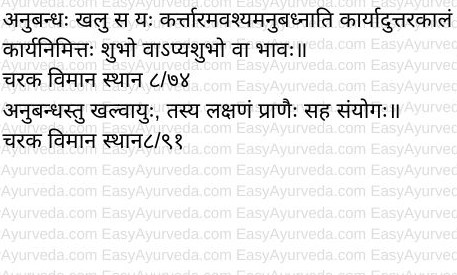Anubandha: Examination of Association Of Patient With Longevity
By Dr Raghuram Y.S. MD (Ay) & Dr Manasa, B.A.M.S
Anubandha means association. Anubandha is the 6th factor to be examined according to Charaka’s ten factors to be examined i.e. dashavidha parikshya bhavas. This shall be understood in relation to the other 5 factors explained before this. For better understanding of anubandha we need to understand the factors related and connected to it. They are –
1. Kaarana – the physician who is the cause for establishing the dosha balance in the patients
2. Karana – the medicines which the physician would use to bring about the balance of doshas while treating the patients
3. Karyayoni – the imbalance of doshas found in the body of the patients, the target for the physician to take action upon
4. Karya – the action that the physician would take and bring about balance of the doshas in the patient effecting in disappearance of the disease
5. Karyaphala – means the outcome of treatment i.e. establishment of happiness / pleasure in the patient which leads to pleasantness of mind, intellect, senses and body and freedom from disease
Read – 10 Factors Of Patient Examination – Dasha Vidha Atura Pareeksha

Table of Contents
Understanding Anubandha
Anubandha follows the outcome of treatment. It means getting associated with or after-effects. In the treatment process, the after-effects found as an effect of outcome of treatment is considered as anubandha.
Definition of Anubandha
As an after-effect of undertaking a certain action, the doer of the action would get associated with good or bad results. This association of the doer with the results as after-effects of the taken action is called as anubandha. In the treatment process association follows the outcome of the treatment. While outcome of the treatment is marked by manifestation of happiness, association of the patient with his lifespan is considered as anubandha.
Read – Roga, Rogi Pareeksha: Examination Of Disease And Patient
Examination of anubandha
Ayu means lifespan. It is not just living for a long time. Ayu has an elaborate meaning. It is the constant association of body, senses, mind and soul.
As long as this association between these 4 components stays intact, the person lives. The healthier the association, the healthier and longer is the life. When someone is afflicted by a disease, the imbalance of doshas and body components would disturb the association between these two factors. When the imbalances are identified as target of treatment i.e. karyayoni and the physician takes appropriate action i.e. karya by balancing the doshas and establishing health in the patient and establishes happiness as an after effect, the association of body, mind, senses and soul once again becomes stronger and stays intact. This is called anubandha.
Sign of Anubandha – Sign of intactness of association of body, mind, senses and soul is reflected by the association of the patient with his life. In other sense, if the patient is living a better and healthy life after the disease has been cured, his or her body, mind, senses and soul are said to be associated in a good way.
Read – Ayu – Meaning, Explanation, Types Of Lifespan
Sanskrit Verses

Anubandha in terms of research
The impact of the after effect will surely leave its impact on the doer after he has performed the action, immaterial of the after effect being good or bad. As far as treatment is concerned, longevity is anubandha i.e. subsequent manifestation.
When we consider research work in this context, subsequent manifestation or after effects can be compared to the long term effects of research study. Teleological ethics can also be considered as anubandha. It is a theory of morality. It derives duty or moral obligation from what is good or desirable as an end to be achieved. Impacts of research on society could be considered as anubandha i.e. subsequent manifestation or after effect of research.
Click to Consult Dr Raghuram Y.S. MD (Ayu)






